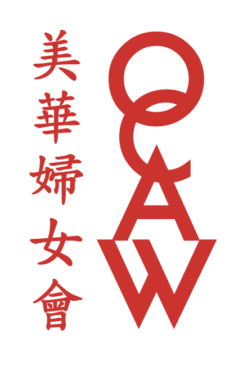National President Maria Yang

Dear Members of OCAW:
I have been an active member of OCAW for more than 10 years, and previously served as the President of the Virginia Chapter from 2014 to 2017. In 2017, OCAW celebrated its 40th Anniversary, and I was pleased to contribute my time and efforts to make this event very successful and memorable. Five years later, in 2022, the National President, Christina Chang, asked me to serve again as the President of the Virginia Chapter and to help with the 45th Anniversary celebration, which I was happy to do. In late 2022, Christina announced her retirement after 12 years of leading OCAW and asked if I would consider taking the reins as National President. I humbly accepted this volunteer position and hope I can follow Christina’s example and make a strong contribution to OCAW.
As a women’s organization, we have come a long way in our 45 years of the journey toward equality
and empowerment. Yet there is still so much work to be done. I believe that this organization has
the potential to make a real impact on the lives of women in the community and the world, and I am
committed to continuing to achieve our goals.
Together, we will strive to break down the barriers that hold us back, empower women of all ages
and backgrounds, and create a world where every woman has the opportunity to reach her full
potential.
It is with great honor and humility that I am here today as your new National President. I am
deeply grateful for your trust and confidence in me to lead this organization toward greater
heights.
Let us move forward with hope and determination, knowing that we have the power to make a
difference in the world. Thank you for giving me the opportunity to learn and serve OCAW!
Sincerely, Maria Yang
National President
Washington, D.C.’s Famous Cherry Blossoms
Maria is the OCAW National President.)
Washington, D.C.’s famous cherry blossoms reached peak bloom on Friday, March 28, 2025, according to the National Park Service. This happened about a week after the city started its annual Cherry Blossom Festival.
Thousands of cherry trees with pink and white flowers surround the Tidal Basin and nearby parks, creating a beautiful scene near some of the city’s famous landmarks.
Peak bloom happens when 70% of the Yoshino cherry trees, the most common type around the Tidal Basin, are in full bloom. The National Park Service, which tracks the trees each year, announced that the March 28 peak bloom was slightly earlier than the average date of April 3 but more than 10 days later than last year’s peak on March 17. Warmer temperatures usually cause the blossoms to bloom earlier.
Saturday, March 29, we went to see the cherry blossoms. Since it was during the three-day peak period, the flowers were in full bloom. The Metro trains were packed with local residents and tourists. Many people take the Metro instead of driving to avoid traffic and parking issues, getting off at the Smithsonian Metro station. Spring’s arrival and the beauty of the blossoms bring large crowds to the Tidal Basin. The best place to see them is around the Tidal Basin in West Potomac Park, but there are also many trees along the Potomac River and Washington Channel in East Potomac Park.
According to the National Park Service, the idea to plant Japanese cherry trees in D.C. dates back to 1885, when writer and diplomat Eliza Ruhamah Scidmore first suggested it.
Japan gifted more than 3,000 cherry trees to the U.S. in 1912 as a symbol of friendship. That year, First Lady Helen Herron Taft and the Japanese ambassador’s wife, Viscountess Chinda Iwa, planted two Yoshino cherry trees along the Tidal Basin. Over the next few years, more trees were planted in the area. We are very fortunate to have this beautiful gift every springtime.  Washington Monument behind the cherry blossoms.
Washington Monument behind the cherry blossoms.
Chinese Calendar History, and 2025, the Year of the Snake
by Maria Yang
 The year 2025 in the traditional Chinese calendar is the Year of the Snake. Snakes are known as “little dragons.” The year begins on January 29, 2025, and ends on February 16, 2026.
The year 2025 in the traditional Chinese calendar is the Year of the Snake. Snakes are known as “little dragons.” The year begins on January 29, 2025, and ends on February 16, 2026.
Based on archaeological evidence, some form of calendar has been used in China for three-and-a half millennia. The Western Gregorian calendar was adopted by the Republic of China effective January 1, 1912, for official business, but the general populace continued to use the traditional calendar. The status of the Gregorian calendar was unclear between 1916 and 1921, when several competing warlords controlled China. From 1921 to 1928, warlords continued to fight over northern China, but the Nationalist government controlled southern China and used the Gregorian calendar.
After the establishment of the ROC by the nationalist government, the Gregorian calendar was officially adopted on January 1, 1929. The People’s Republic of China has continued to use the Gregorian calendar since 1949.
The Chinese traditional calendar is lunisolar, incorporating elements of a lunar calendar with those of a solar calendar. It is not exclusive to China but is followed by many other Asian cultures.
The Gregorian calendar is used for day-to-day activities in Taiwan. However, the traditional calendar is still used to mark traditional holidays such as the Chinese New Year, the Dragon Boat Festival, and the Mid-Autumn Festival. It is also used in Chinese astrology – for example, when choosing the most auspicious date for a wedding or building opening.
Unsurprisingly, some of the earliest printed items were calendars, since the Chinese found it necessary to calculate and mark which days were auspicious and which were not.
The two oldest printed Chinese calendars are dated 877 and 882; they were found at the Buddhist pilgrimage site of Dunhuang, China.
The practical benefit of this system is that the calendar is able to keep pace with the solar cycle while at the same time retaining months that roughly correspond with lunar cycles. Hence, the term Lunisolar calendar. The latter is essential because many traditional festivals correspond to significant moon cycle events. For example, the Mid-Autumn Festival is always on a day of the full moon.
The stem-branch cycle is the other system by which years are marked historically in China. This system is based on two forms of counting: a cycle of 10 Heavenly Stems and 12 Earthly Branches. Each year is named after a pair of one stem and one branch called a stem-branch. The 10 Heavenly Stems are associated with Yin Yang and the Five Elements. The 12 Earthly Branches are associated with the 12 signs of the Zodiac. Each Earthly Branch is also associated with an animal, collectively known as the Twelve Animals.
Therefore, this year is called “the Year of Yi-Si, or the Year of Snake, the Year of Wood Snake, or the Year of Green Snake.” Wood is one of five elements, and green or blue is the color of wood.
The Chinese calendar remains culturally essential today. Most traditional festivals, such as Chinese New Year and the Mid-Autumn Festival, occur on new or full moons. As an element of conventional culture, the traditional calendar has much cultural and national sentiment invested in it. The calendar is still used in more traditional Chinese households worldwide to pick auspicious dates for important events such as weddings, funerals, and business deals.
As stated in the 2025 Yun Lin Temple published calendar, written by Khadro Chu Rinpoche, Spiritual leader at Yun Lin Temple, “the Green Snake year will gradually break free from the chaotic and tumultuous situation of the previous two years, transitioning from ambiguity to gradual clarity… Thus, the year should be a year of positive upward change.”
Happy Lunar New Year! I wish everyone a prosperous, healthy, and productive year!
Contact us. OCAW National Office
P O Box 3443
Oakton, VA 22124
E-mail: info@ocawwomen.org
OCAW Local Chapters
Hawaii hawaii@ocawwomen.org
Maryland maryland@ocawwomen.org
New Orleans neworleans@ocawwomen.org
Silicon siliconvalley@ocawwomen.org
Virginia virginia@ocawwomen.org
